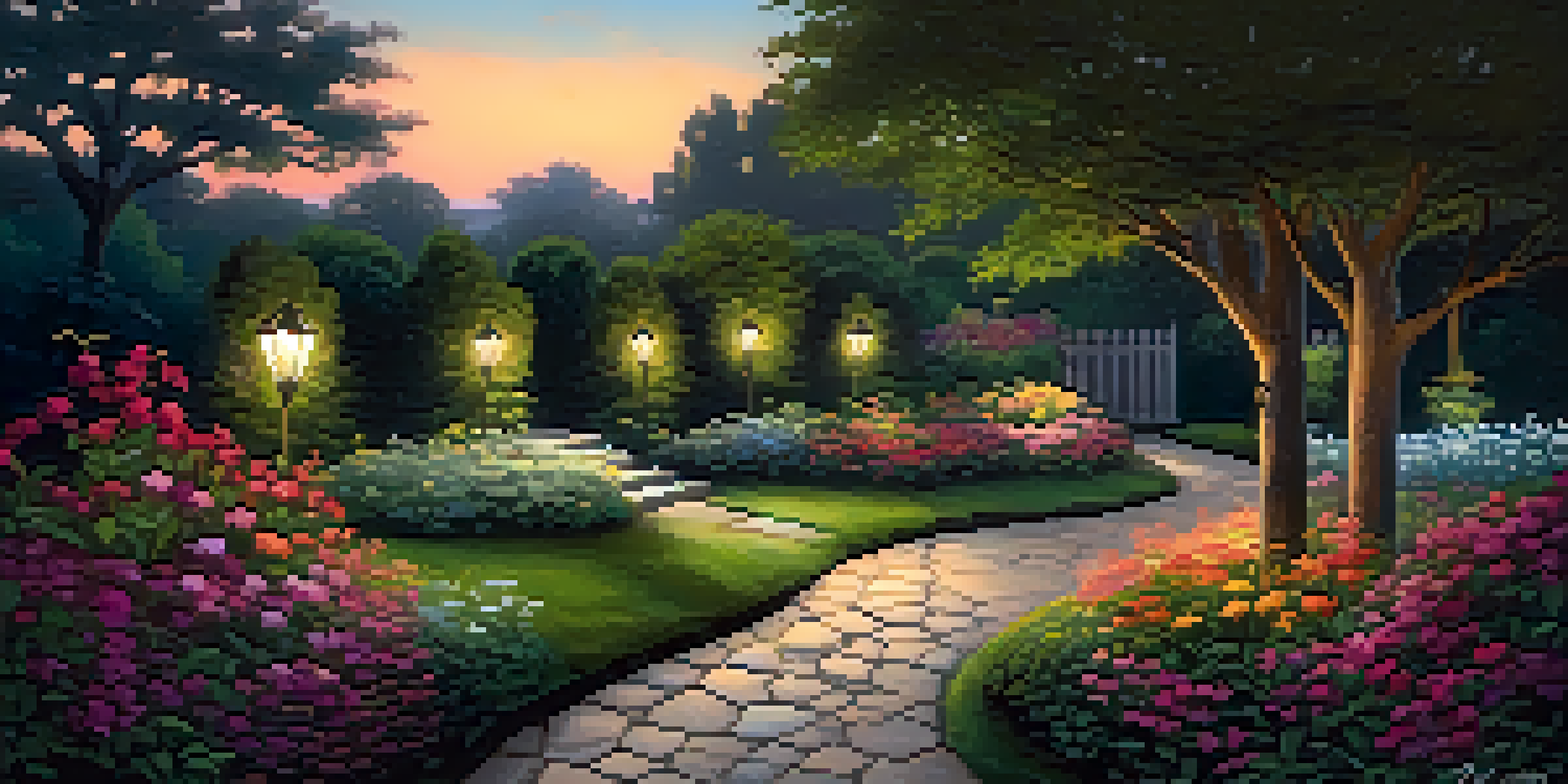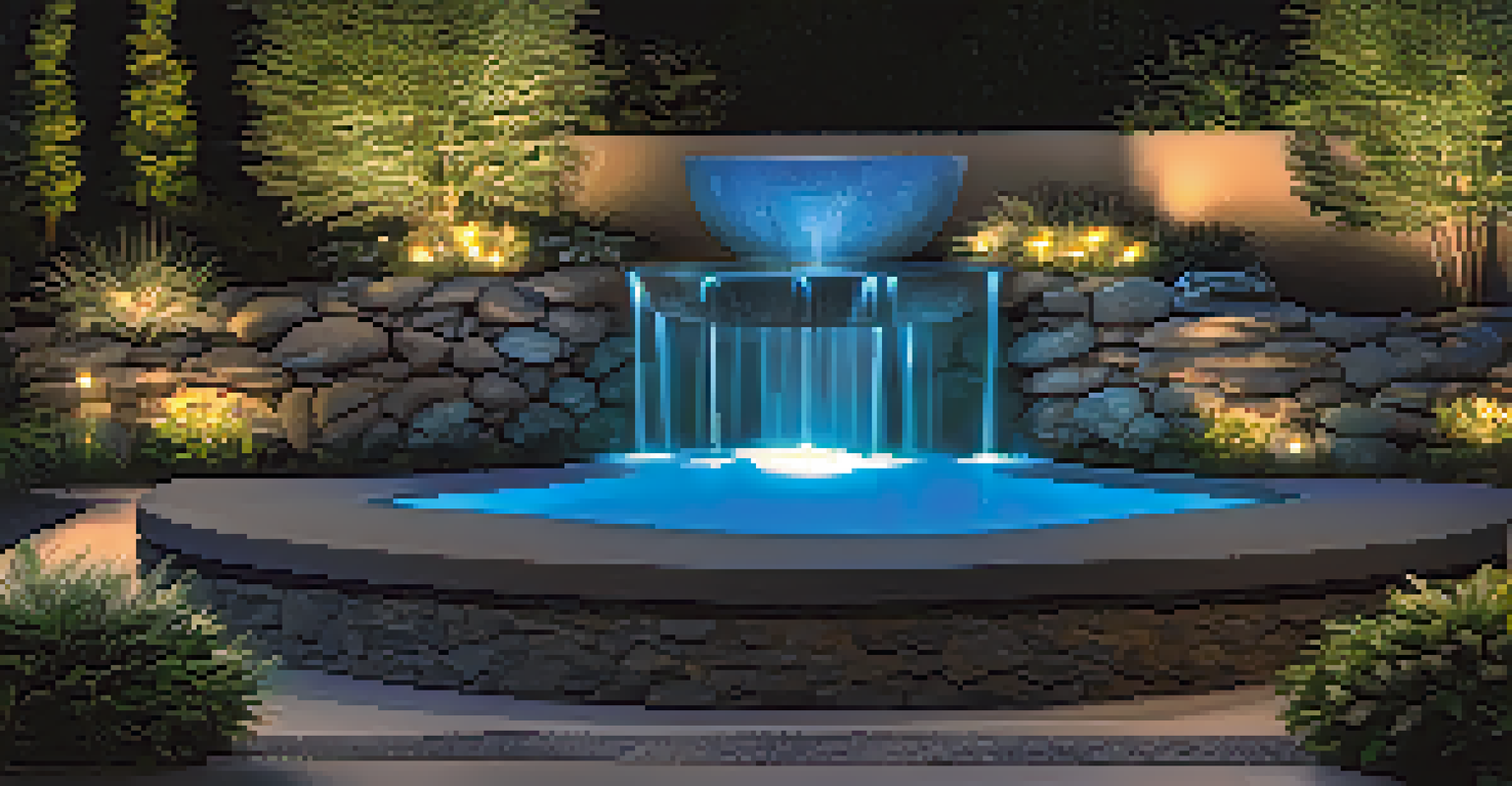Using Lighting to Highlight Key Features in Your Landscape

Understanding the Importance of Landscape Lighting
Landscape lighting serves more than just visibility; it creates ambiance and highlights the beauty of your outdoor space. Imagine walking through a garden at night where soft lights illuminate the paths and plants, transforming the environment into a magical oasis. Proper lighting can not only enhance aesthetic appeal but also improve safety and security in your outdoor areas.
A garden is a grand teacher. It teaches patience and careful watchfulness; it teaches industry and thrift; above all, it teaches entire trust.
By strategically placing lights, you can draw attention to specific features like trees, sculptures, or water elements. This technique not only increases the visual interest of your landscape but also allows you to enjoy these features long after the sun sets. Think of lighting as the brush strokes of an artist, where each placement enhances the overall masterpiece.
Furthermore, utilizing lighting can extend the usability of your outdoor spaces. An inviting patio with well-placed lights encourages gatherings and relaxation, making your landscape a true extension of your home. In essence, effective landscape lighting can transform your yard from a daytime retreat to a nighttime spectacle.
Choosing the Right Type of Landscape Lighting
When it comes to landscape lighting, there are several types to consider, each with its unique purpose. Path lights are great for illuminating walkways, while spotlights can focus on specific features like a beautiful tree or artwork. Additionally, wall-mounted lights can add depth to vertical surfaces, enhancing the overall design.

Another option is ambient lighting, which creates a soft, diffused glow that fills a space without overwhelming it. This type of lighting is perfect for creating a cozy atmosphere for evening gatherings. Think of it as the gentle background music to your outdoor event, subtly enhancing the mood without stealing the show.
Enhancing Ambiance with Lighting
Landscape lighting not only improves visibility but also creates a magical atmosphere that highlights the beauty of outdoor spaces.
Lastly, don’t forget about solar lights, which are eco-friendly and easy to install. They harness sunlight during the day to power themselves at night, making them a convenient and cost-effective choice for many homeowners. With a variety of options available, you can tailor your landscape lighting to fit your style and needs.
Highlighting Key Features with Focused Lighting Techniques
To truly make a statement in your landscape, focused lighting techniques are essential. Techniques such as uplighting and downlighting can dramatically change the perception of your outdoor features. Uplighting, for example, can create a striking silhouette of a tree, making it appear even more majestic against the night sky.
Nature does not hurry, yet everything is accomplished.
Downlighting mimics natural moonlight and can create a serene atmosphere in your garden. By positioning lights high in trees or on structures, the soft glow can illuminate pathways and highlight garden beds, creating a magical feel reminiscent of a fairy tale. These techniques not only enhance beauty but also add depth and dimension to your landscape.
Additionally, consider using colored lights to provide a unique twist. For instance, a soft blue light can create a calming effect around water features, while warm tones can make seating areas feel inviting. By experimenting with these techniques, you can create a dynamic and engaging outdoor environment.
Creating Layers with Different Lighting Sources
One of the most effective ways to enhance your landscape is by creating layers of light. Just as a painter uses various shades to bring depth to a canvas, layering lighting can create a rich tapestry in your outdoor space. Start with ambient lighting for overall illumination, then add task lighting for specific areas, followed by accent lighting to highlight particular features.
This combination not only adds visual interest but also guides the viewer’s eye throughout your landscape. For example, an illuminated pathway can lead guests to a beautifully lit sculpture, creating a journey that is both functional and aesthetically pleasing. It's all about creating a flow that invites exploration.
Types of Landscape Lighting
Choosing the right type of lighting, such as path lights, spotlights, and solar options, allows homeowners to customize their outdoor experience.
Moreover, layering allows you to adapt your lighting to different occasions. For a casual family gathering, you might keep it warm and inviting, while a more formal event could call for brighter, more focused lighting. This flexibility ensures that your landscape remains versatile and enjoyable, no matter the occasion.
Incorporating Natural Elements into Your Lighting Design
Nature can be your best ally when designing your landscape lighting. By incorporating natural elements, such as trees and rocks, into your lighting plan, you can create harmonious and visually appealing effects. For instance, strategically placed lights can cast interesting shadows and highlight the textures of stone walls or tree bark.
Using the landscape's existing features can also help you minimize the need for additional lighting fixtures, making your design both efficient and effective. Imagine how a boulder illuminated from below can turn into a stunning focal point at night, showcasing its rugged beauty and adding character to your garden.
Additionally, consider how different seasons might affect your lighting design. A tree may look different in winter compared to summer, and adjusting your lighting can enhance those seasonal changes. This approach not only adds interest but also ensures that your outdoor space feels alive throughout the year.
Energy Efficiency and Sustainability in Landscape Lighting
As we become more conscious of our environmental impact, energy-efficient lighting options are becoming increasingly popular in landscape design. LED lights, for instance, consume significantly less power than traditional incandescent bulbs and can last much longer. This means you can enjoy beautiful lighting while reducing your energy bills and carbon footprint.
Moreover, incorporating solar-powered lights can enhance your sustainability efforts. These lights harness the sun’s energy during the day and use it to illuminate your landscape at night, providing an eco-friendly solution that requires no wiring. It's a simple way to go green while still achieving a stunning outdoor aesthetic.
Sustainability in Lighting Choices
Utilizing energy-efficient and solar-powered lights can enhance your landscape while reducing your environmental impact.
By being mindful of your lighting choices, you can create an environmentally friendly landscape that doesn't compromise on style. In fact, many homeowners find that energy-efficient options provide the perfect balance of beauty and sustainability, allowing them to enjoy their outdoor spaces guilt-free.
Maintaining Your Landscape Lighting for Longevity
Once you've invested in your landscape lighting, maintaining it is key to ensuring its longevity and effectiveness. Regularly check fixtures for dirt and debris that can block light and diminish their impact. A simple cleaning can make a world of difference, allowing your lights to shine as brightly as the day they were installed.
Additionally, inspect your lighting systems periodically for any signs of wear or damage. This includes checking for frayed wires or burned-out bulbs. Addressing these issues promptly not only keeps your lighting functional but also prevents potential safety hazards.

Lastly, consider updating your lighting design as your landscape evolves. As plants grow and features change, your lighting should adapt accordingly. Whether it’s repositioning lights or adding new fixtures, keeping your lighting current will ensure that your landscape continues to look its best throughout the years.